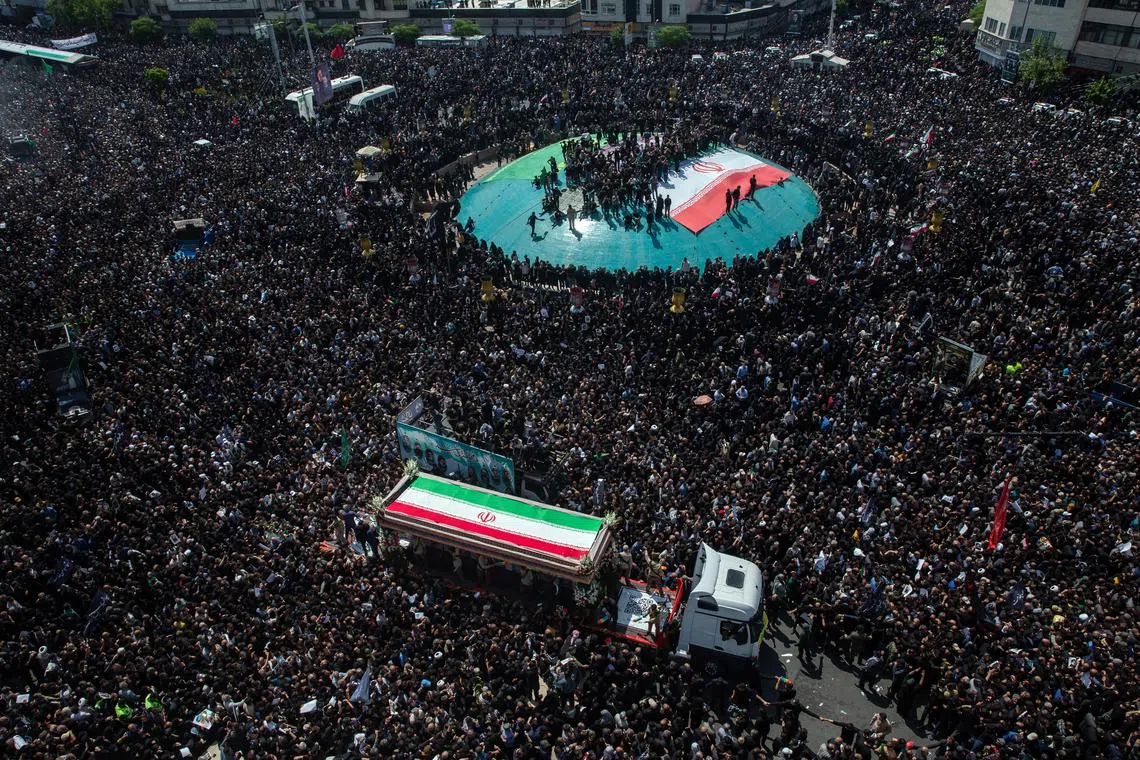After Raisi funeral, Iran’s focus turns to vote for successor
Sign up now: Get ST's newsletters delivered to your inbox

A truck carrying the coffins of the late President Ebrahim Raisi, Foreign Minister Hossein Amir Abdollahian and others is driven through mourners during a funeral procession in Tehran on May 22.
PHOTO: NYTIMES
Follow topic:
TEHRAN - After Iran’s mourning of President Ebrahim Raisi, who died in a helicopter crash for his successor
The lead-up to the vote on June 28
Ultraconservative Raisi, who had more than a year left of his first term, died on May 19 alongside his Foreign Minister Hossein Amirabdollahian and six others when their helicopter crashed into a fog-shrouded mountainside.
They were laid to rest after multi-day funeral rites drawing mass crowds of mourners.
The vote in June will be held during a turbulent time, as the Gaza war rages between Iran’s arch-foe Israel and Tehran-backed Palestinian militant group Hamas, and amid continued diplomatic tensions over Iran’s nuclear programme.
Iran also faces sustained economic hardship, exacerbated by tough sanctions reimposed by the United States after it withdrew from a landmark 2015 nuclear deal.
Mr Khamenei, who has the final say in all matters of state, has assigned Mr Raisi’s vice-president, Mr Mohammad Mokhber, 68, to assume interim duties for the next few weeks and organise the June election.
Media reports suggest Mr Mokhber himself plans to run for Iran’s second-highest post, as do Parliament Speaker Mohammad Bagher Ghalibaf and several prominent former officials.
Among other hopefuls, ultraconservative former nuclear negotiator Saeed Jalili was one of the first to announce his candidacy.
Other contenders include moderate former foreign minister Mohammad Javad Zarif, and centrist Ali Larijani, a former Parliament speaker.
Populist former president Mahmoud Ahmadinejad has so far kept voters guessing and said he is “checking the conditions to decide whether to register”.
“We have to wait for positive developments in the country,” he added.
Vetting process
Iran was rocked in late 2022 by nationwide protests sparked by the death in custody of Ms Mahsa Amini, a 22-year-old Iranian Kurd, following her arrest in Tehran over an alleged breach of the strict dress code for women.
Hundreds of people, including dozens of security personnel, were killed and thousands were arrested.
Political expert Abbas Abdi told reformist newspaper Hammihan that if Iran’s “protesting community” sees an opportunity for change, it “will show its protest, activism and responsibility through participating in the election”.
He said that he was “sure that the reformists will win with a huge margin”, but only if they are allowed to participate – a major concern after many candidates were disqualified ahead of recent elections.
Mr Abdi added that, if the authorities permit a broad spectrum of candidates to run this time, “it will create the necessary hope in the people and lead to high participation”.
Candidate registration begins on May 30 and closes on June 3. Hopefuls will then be vetted by the 12-member Guardian Council, which has barred many candidates in the past, among them Mr Ahmadinejad and Mr Larijani.

The deaths of President Ebrahim Raisi and Foreign Minister Hossein Amir Abdollahian left the country without two of its most influential figures at a moment of regional and domestic tumult.
PHOTO: NYTIMES
Recent parliamentary and presidential elections have seen declining turnout, despite efforts by the authorities to encourage people to vote.
Ahead of Iran’s parliamentary elections held on March 1, the Guardian Council disqualified tens of thousands of candidates.
With many of those barred reformists or moderates, the vetting helped Iran’s conservative and ultraconservative factions to tighten their grip on power in an election that saw the lowest turnout since the Islamic Revolution of 1979.
Low voter turnout
The 2021 election that brought Mr Raisi to power also saw many reformist and moderate figures disqualified from the race, and the turnout hit a record low for any presidential polls in Iran.
During his years in office, Mr Raisi faced a barrage of criticism from former officials and activists, including over his handling of an already fragile economy.
Raging inflation, rampant unemployment and record currency depreciation dogged Mr Raisi’s presidency, while his government failed to clinch a deal with Washington to revive the nuclear deal and lift sanctions.
He also faced criticism for the government’s handling of the street protests sparked by Ms Amini’s death.
More recently, spillover from the Gaza war saw tensions with Israel skyrocket and climax in mid-April when Iran carried out its first-ever direct attack against Israel.
Iranian forces and allied groups unleashed hundreds of drones and missiles, most of which were intercepted by Israel and its partners.
Amid all the turmoil, Iran’s leaders have urged a calm election process.
On May 27, the new Parliament opened its first session with a message from Mr Khamenei urging lawmakers to avoid “useless media contests and harmful political controversies”.
On May 28, Mr Ghalibaf won re-election as Speaker with the support of 198 of Iran’s 287 MPs, a vote analysts said was likely to diminish his chances of becoming president. AFP

